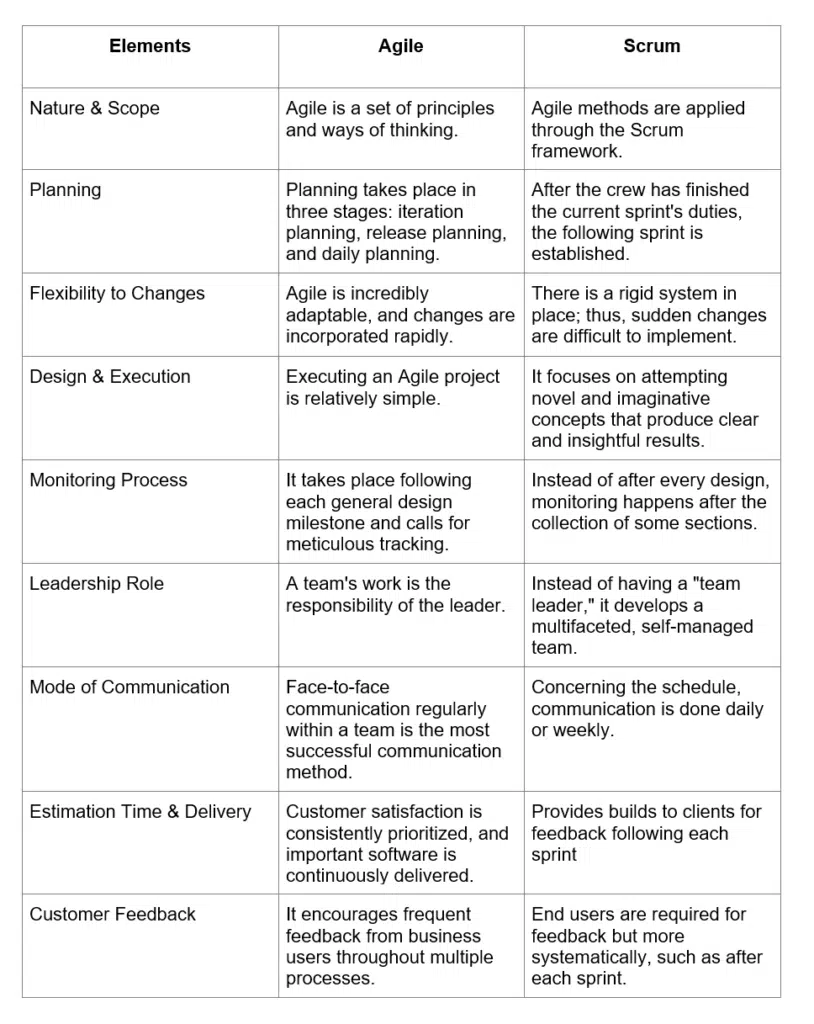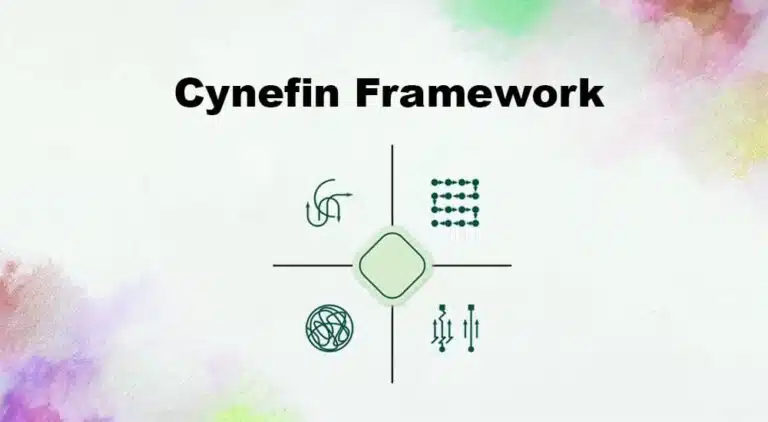Many project management professionals use the terms “Scrum” and “Agile” interchangeably, but they are different.
Agile is a collection of frameworks that emphasize completing projects in incremental steps. These methodologies are useful for unpredictable projects, and Scrum is one of many different Agile frameworks.
In today’s blog post, I will explain Agile and Scrum and the difference between these two frameworks.
The History of Agile: In the spring of 2000, 17 software developers, including Martin Fowler, Jim Highsmith, Jon Kern, Jeff Sutherland, Ken Schwaber, and Bob Martin, met in Oregon to discuss speeding up the software development process and launching quick products.
A few months later, they met again in the Wasatch Mountains of Utah in February to plan a list of principles, believing that it would help create a healthier organizational culture.
The outcome was the Agile Manifesto with four Agile values and twelve Agile principles.
What is Agile?
Agile methodologies accomplish the goal by developing the product incrementally. Agile projects do not deliver the product at once; instead, they are broken up into smaller parts of product updates, each of which can be delivered incrementally. The next delivery will build upon the previous one after incorporating the client’s feedback.
This helps project teams adapt to shifting priorities and respond to changes, requirements, and problems as they arise during product development.
To use Agile processes, the organization must use any Agile framework. Scrum is the most popular framework. Other popular Agile frameworks are Kanban, Extreme Programming, SAFe, etc.
In Agile methodologies, you develop the product iteratively.
According to the Project Management Institute (PMI), the objective of the Agile methodology is to provide an early and measurable return on investment (ROI) through the iterative delivery of product features.
Agile processes encourage regular client participation to ensure that their expectations are met and to allow the development team to adjust and update products to align with their requirements.
When Should You Use Agile?
The Agile framework is useful for projects with undefined requirements. It is ideal for projects dealing with unpredictable changes in product development or developing new products. Traditional project management approaches are useful for projects with well-defined scope.
What Are the Benefits of Agile?
- Better Quality Product: Testing is integral to Agile methodology to ensure high product quality. The client is involved in product development, and their feedback is regularly incorporated. This ensures better product quality and fulfilled client expectations.
- Higher Customer Satisfaction: The client is involved in the decision-making process throughout the project lifecycle. Based on their feedback, the product is updated, which increases customer satisfaction.
- Reduced Risks: In principle, Agile projects should never fail. Agile is implemented in tiny sprints, with an emphasis on continuous delivery. If a technique does not work, then the team can change it in the next update.
- Better Adaptability: Agile frameworks offer unprecedented flexibility. The client can review the product, and if they require any changes, then they can be prioritized in the next sprints. By comparison, changes in traditional approaches are time-consuming and costly.
- Constant Improvement: The processes are iterative, so the subsequent sprint will be more successful than the one before it, and errors from the previous sprint will not be repeated.
- Increased Team Spirit: Agile teams are self-organized and self-managing. They have independence and control over their judgments. The project manager protects the team from external influences. Additionally, the team’s cross-functional nature helps members learn new skills. When combined, all these facets help improve team spirit.
Disadvantages of Agile Methodologies
Due to frequent changes in requirements, agile methodology has the potential for scope creep. This can cause delays and increase costs. Agile processes can also strain team cohesion, as constant iterations can cause burnout and frustration.
Agile methodologies are not suitable for projects with rigid timelines, well-defined scopes, or regulatory constraints. Without proper attention, Agile can lack documentation, thus risking knowledge and continuity losses.
What is Scrum?
According to this report, Scrum is the most popular agile framework. About 66% of Agile users use Scrum, and 15% use derivatives of Scrum.
Scrum emphasizes iterative development, collaboration, and flexibility in responding to change. Scrum teams work in short cycles called sprints, which last two to four weeks. During these sprints, they deliver a shippable product increment.
Key roles in Scrum are the Product Owner, who represents stakeholder interests and manages the product backlog; the Scrum Master, who facilitates the team and ensures adherence to Scrum principles; and the Development Team, which builds the product.
Key Scrum ceremonies are sprint planning, daily stand-up, sprint review, and sprint retrospectives.
By promoting self-organization and regular feedback loops, Scrum enables teams to adapt to changing requirements and deliver value quickly and efficiently.
The three pillars of Scrum are:
- Transparency: Scrum promotes transparency by making all project information visible to everyone involved. Transparency helps build trust among team members and stakeholders, thus enabling effective communication and decision-making.
- Inspection: Scrum emphasizes regular product and process inspection to detect any deviations from either the desired outcome or the agreed-upon standards. Inspection is the key to maintaining quality and adapting to changes.
- Adaptation: Scrum encourages adaptation, based on the insights gained from inspection, testing, and user feedback. By embracing change and continuously improving, Scrum teams can respond quickly to evolving requirements, market conditions, and client feedback.
When Should You Use Scrum?
You can use Scrum when the project requires iterative and incremental delivery, rapid response to feedback, and close collaboration among team members and stakeholders. It is beneficial in environments where flexibility, transparency, and continuous improvement are valued. Scrum enables teams to deliver high-quality products efficiently, adapt to changes quickly, and maximize customer satisfaction by frequently delivering valuable increments.
Disadvantages of Scrum Methodologies
Being a subset of Agile, Scrum inherits drawbacks of Agile methodologies.
The key disadvantage of Scrum methodologies is its reliance on strong team collaboration and self-organization, which can falter if team members lack experience or cohesion.
If not properly planned, fixed-length iterations (sprints) may lead to rushed deliverables or products with incomplete features. The emphasis on time boxing can cause stress and compromise quality.
Agile Vs Scrum
The table below shows the difference between Agile and Scrum.

Agile Vs Other Methodologies
Although Scrum is the most popular Agile framework, a few other methodologies are also useful for managing Agile projects.
We will discuss a few of them here.
Agile Vs Kanban
Unlike other Agile methodologies, Kanban doesn’t have fixed-length iterations or specific roles. It focuses on visualizing work on a Kanban board, limiting work in progress (WIP), and encouraging continuous improvement. Team members pull work items from a backlog as capacity allows and work on them.
This approach differs from Scrum’s structured sprints and defined roles like Scrum Master and Product Owner. Kanban doesn’t mandate time-boxed events such as sprint planning or retrospectives, allowing teams to adapt their processes organically.
Kanban’s flexibility, emphasis on visualization, and focus on continuous delivery make it a unique Agile methodology.
Agile Vs Extreme Programming (XP)
Extreme Programming (XP) differs from other Agile methodologies through its strong emphasis on engineering practices and customer involvement. Unlike Scrum, which focuses on iterative development within fixed-length sprints, XP prioritizes continuous integration, test-driven development (TDD), pair programming, and frequent releases.
XP teams work closely with customers, involving them directly in the development process through practices like user stories and on-site customer presence. This contrasts with Kanban’s focus on workflow visualization and limiting work in progress.
XP emphasizes technical excellence and team collaboration, with practices like collective code ownership and refactoring.
Conclusion
Scrum is one of many Agile frameworks. You must understand your project’s requirements to determine the best Agile methodology for it. Scrum works best for projects which do not have clearly defined requirements, and that call for testing at regular intervals.

I am Mohammad Fahad Usmani, B.E. PMP, PMI-RMP. I have been blogging on project management topics since 2011. To date, thousands of professionals have passed the PMP exam using my resources.






